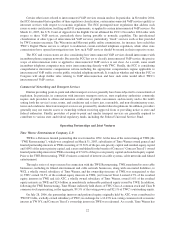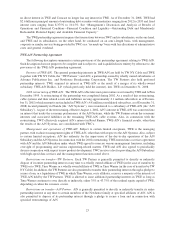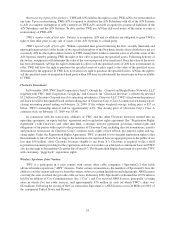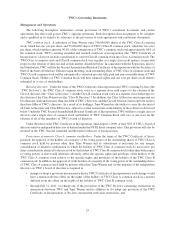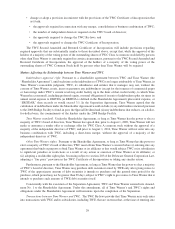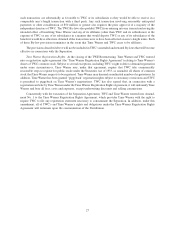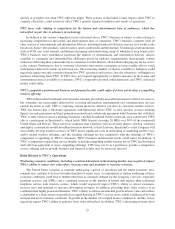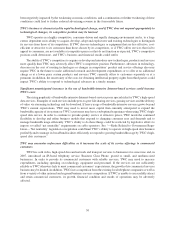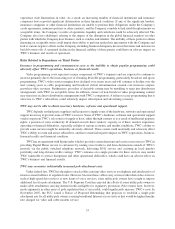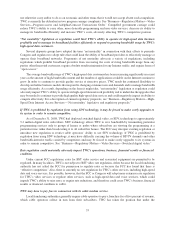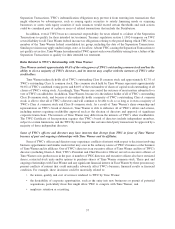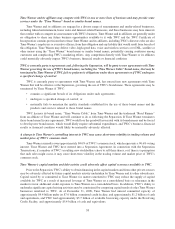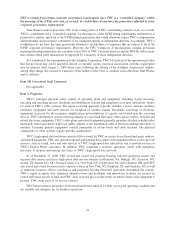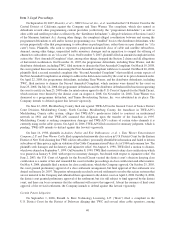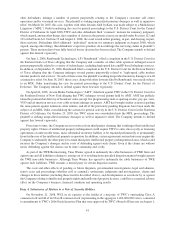Time Warner Cable 2008 Annual Report Download - page 42
Download and view the complete annual report
Please find page 42 of the 2008 Time Warner Cable annual report below. You can navigate through the pages in the report by either clicking on the pages listed below, or by using the keyword search tool below to find specific information within the annual report.TWC’s 2008 annual impairment analysis, which was performed as of December 31, 2008, resulted in a
noncash pretax impairment on its cable franchise rights of $14.822 billion, and as a result, the carrying values of the
Company’s impaired cable franchise rights were re-set to their estimated fair values as of December 31, 2008.
Consequently, any further decline in the estimated fair values of these cable franchise rights could result in
additional cable franchise rights impairments. It is possible that such impairments, if required, could be material and
may need to be recorded prior to the fourth quarter of 2009 (i.e., during an interim period) if the Company’s results
of operations or other factors require such assets to be tested for impairment at an interim date. See “Management’s
Discussion and Analysis of Results of Operations and Financial Condition—Critical Accounting Policies and
Estimates—Asset Impairments—Goodwill and Indefinite-lived Intangible Assets” and “—Long-lived Assets.”
The IRS and state and local tax authorities may challenge the tax characterizations of the Adelphia Acquisition,
the Redemptions (as defined below) and the Exchange (as defined below), or TWC’s related valuations, and any
successful challenge by the IRS or state or local tax authorities could materially adversely affect TWC’s tax
profile, significantly increase TWC’s future cash tax payments and significantly reduce TWC’s future earnings
and cash flow.
The Adelphia Acquisition was designed to be a fully taxable asset sale, the redemption by TWC of Comcast’s
interests in TWC (the “TWC Redemption”) was designed to qualify as a tax-free split-off under section 355 of the
Internal Revenue Code of 1986, as amended (the “Tax Code”), the redemption by TWE of Comcast’s interests in
TWE (the “TWE Redemption” and collectively with the TWC Redemption, the “Redemptions”) was designed as a
redemption of Comcast’s partnership interest in TWE, and the exchange between TW NY Cable and Comcast
immediately after the Adelphia Acquisition (the “Exchange”) was designed as an exchange of designated cable
systems. There can be no assurance, however, that the Internal Revenue Service (the “IRS”) or state or local tax
authorities (collectively with the IRS, the “Tax Authorities”) will not challenge one or more of such character-
izations or TWC’s related valuations. Such a successful challenge by the Tax Authorities could materially adversely
affect TWC’s tax profile (including TWC’s ability to recognize the intended tax benefits from the Adelphia/
Comcast Transactions), significantly increase TWC’s future cash tax payments and significantly reduce TWC’s
future earnings and cash flow. The tax consequences of the Adelphia Acquisition, the Redemptions and the
Exchange are complex and, in many cases, subject to significant uncertainties, including, but not limited to,
uncertainties regarding the application of federal, state and local income tax laws to various transactions and events
contemplated therein and regarding matters relating to valuation.
TWC has incurred substantial debt, which may limit its flexibility, prevent it from taking advantage of business
opportunities and negatively affect its ability to refinance existing debt.
In connection with the Separation, TWC incurred $7.0 billion of indebtedness pursuant to the 2008 Bond
Offerings to fund, in part, the Special Dividend and expects to incur additional indebtedness to fund the Special
Dividend and expenses related to the Separation Transactions through a combination of borrowings under the 2008
Bridge Facility, additional financing in the public debt markets and/or borrowings under TWC’s $6 billion senior
unsecured five-year revolving credit facility (the “Revolving Credit Facility”). The increased indebtedness and the
terms of these financing arrangements and any future indebtedness will impose various restrictions on TWC that
could limit its ability to respond to market conditions, provide for capital investment needs or take advantage of
business opportunities. Also, as a result of TWC’s increased borrowings, its interest expense will be higher than it
has been in the past, which will affect TWC’s profitability and cash flows.
In addition, the Revolving Credit Facility and TWC’s $3.045 billion five-year term loan facility both mature in
2011. At this time it is difficult to forecast the future state of the bank loan market. As a result of TWC’s substantial
debt levels and the uncertain state of various financial institutions and the credit markets generally, TWC may be
unable to refinance its bank facilities in the same amount and on the same terms as its current facilities, which could
negatively impact its liquidity and results of operations.
TWC is exposed to risks associated with turmoil in the financial markets.
U.S. and global credit and equity markets have recently undergone significant disruption, making it difficult
for many businesses to obtain financing on acceptable terms. In addition, equity markets are continuing to
32


